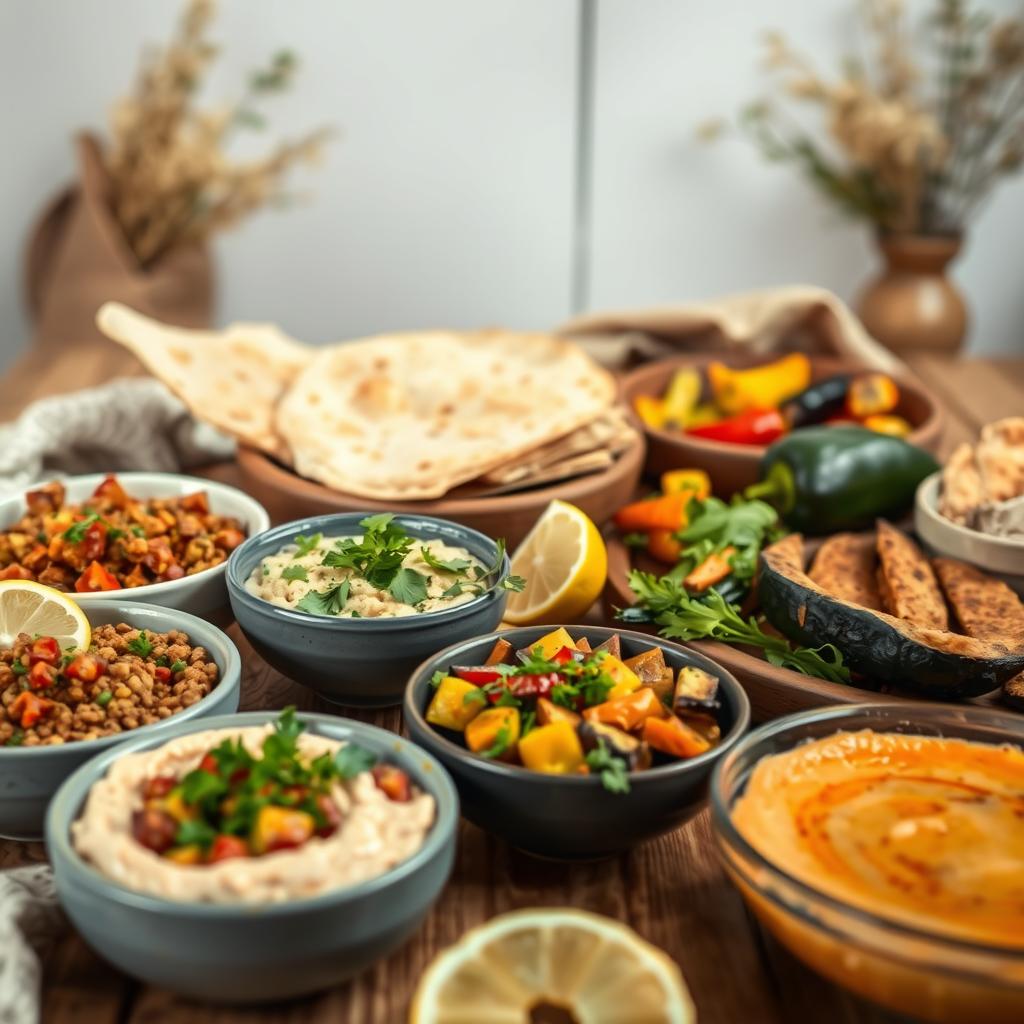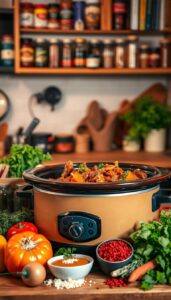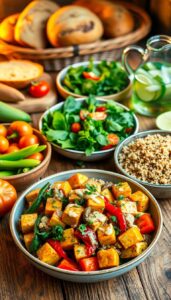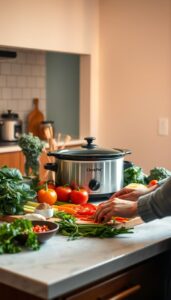vegan lebanese recipes can feel both timeless and fresh when you know the simple techniques and pantry staples to rely on.
You grew up loving bright herbs, citrus, grains, and legumes. Here you’ll learn how to turn those elements into everyday meals in your U.S. kitchen.
Can a weeknight spread capture the balance and sharing spirit of mezze while staying fast and practical? This guide shows you how.
Expect clear steps on what to cook now, what to prep ahead, and which ingredients to stock. I highlight items like parsley, bulgur, lentils, chickpeas, za’atar, and pomegranate molasses so your lebanese food keeps its signature flavor.
You’ll find approachable techniques for charring eggplant, caramelizing onions, and smart swaps for U.S. grocery shelves. By the end, you’ll pair dishes into balanced plates that honor tradition and your plant-based lifestyle.
Key Takeaways
- You’ll get an at-a-glance plan for weeknight and weekend meals.
- Core ingredients and smart swaps make shopping simple.
- Basic techniques bring authentic flavor with minimal fuss.
- Focus on mezze-style plates to mix and match dishes.
- Storage tips and make-ahead options save time.
vegan lebanese recipes you’ll love right now
Start with a few crowd-pleasers that translate easily to weeknight meals and weekend spreads.
Build a simple rotation around a handful of dishes that store well and play nicely together. These picks put protein, creaminess, and hearty grains at the center of your plate.
Falafel with tahini sauce, tomato, parsley, and pickles
Make a big batch, freeze extras, and re-crisp in a hot oven for a fast plant-based protein. For pairing tips and a tested method, see this DoFollow guide: https://www.seriouseats.com/falafel-recipe.
Classic hummus and creamy tahini dip pairing
Serve hummus with an extra drizzle of tahini and thin with ice water for ultra-smooth texture. Add warmed pita, crisp veg, and pickles to balance the creamy spread.
Mujadara (lentils and rice with lots of caramelized onion)
Simmer lentils and rice until tender, then crown with deeply caramelized onion for aroma and texture. A clear how-to is available here: https://zaatarandzaytoun.com/how-to-make-the-best-mujadara/.
Vegan stuffed grape leaves with golden potatoes
Roll leaves snugly and stack them tightly in the pot. Let golden potatoes under the rolls cook into a built-in side. For rolling tips and a classic version, visit: https://zaatarandzaytoun.com/vegan-stuffed-grape-leaves/.
- Quick tip: Layer tahini sauce, tomato, parsley, and pickles in a wrap so each bite hits creamy, tangy, and fresh. See pairing inspiration: https://zaatarandzaytoun.com/vegan-lebanese-recipes/.
Mezze essentials to start your plant-based spread
Begin your mezze with a trio of savory dishes that layer smoky, spicy, and tangy notes.
Smoky baba ganoush (moutabal) finished with good olive oil
Char whole eggplants over a flame or under a broiler until they collapse. Peel and mash the flesh into a creamy base, then finish with a generous drizzle of extra virgin olive oil for fruity, peppery depth. DoFollow: https://zaatarandzaytoun.com/baba-ghanoush-moutabbal/
Batata harra (spicy cilantro garlic potatoes)
Fry or roast potatoes until crisp outside and tender inside. Toss hot potatoes with lots of cilantro, gently cooked garlic, lemon, and chili for a bright, spicy side. Control bitterness by keeping garlic fragrant, not brown. DoFollow: https://zaatarandzaytoun.com/batata-harra/
Loubia b’zeit (green beans in tomato sauce) with flatbread
Simmer green beans in a tomato sauce scented with onions and warm spices. Use fresh or frozen green beans and canned tomatoes off season; add a splash of water for a glossy sauce. Serve with warm flatbread to scoop every drop. DoFollow: https://zaatarandzaytoun.com/loubia-bzeit-green-beans-in-tomato-sauce/
| Dish | Key texture | Finish |
|---|---|---|
| Baba ganoush | Creamy, smoky | Extra virgin olive oil |
| Batata harra | Crisp outside, soft inside | Cilantro, lemon, chili |
| Loubia b’zeit | Tender beans in sauce | Warm flatbread for scooping |
Tip: Build contrast on the plate—creamy dip, crisp potatoes, and saucy green beans—to showcase your vegetables and make sharing simple.
Fresh Lebanese salads bursting with herbs and citrus
Herb-forward salads bring instant brightness to any mezze plate. These bowls rely on herbs, citrus, and a few smart textures so each bite feels lively and clean.
Fattoush with a drizzle of pomegranate molasses
Build a vibrant fattoush with crunchy vegetables, herbs, and toasty flatbread shards. Finish with a light drizzle of pomegranate molasses for a sweet-tart lift. DoFollow
When you order out in the U.S., ask for “no bread, dressing on the side, easy on the lemon.” That keeps texture balanced and acidity under control. For practical ordering tips see this guide: DoFollow
Tabbouleh that lets parsley, tomato, and bulgur shine
Let parsley be the star in tabbouleh. Use fine bulgur sparingly and fold in tomato, mint, and scallions so herbs stay prominent.
Briefly soak or quick-parboil the bulgur so it is tender but not mushy. Taste the dressing and adjust salt and acidity slowly; a restrained lemon hand preserves the delicate herb profile.
- Serve fattoush alongside grilled vegetables and add sumac to boost citrus notes without extra juice.
- Seed juicy tomatoes to keep salads crisp for make-ahead lunches.
- Use high-quality olive oil in the sauce or dressing for a clean, rich finish.
Hearty soups and stews for cozy, nourishing dinners

A warm pot on the stove can turn basic pantry staples into a memorable weeknight dinner. Pick a base—red lentils or toasted freekeh—and build flavor with simple steps that fit a busy U.S. kitchen.
Red lentil soup inspired by authentic kitchens
Sweat onions and carrots, then bloom cumin and coriander in the pan. Add rinsed red lentils and stock, simmer until the lentils collapse, and blend partially for a silky, protein-rich bowl.
Brighten with lemon and chopped parsley before serving. Keep salt moderate early; lentils absorb seasoning as they soften.
Veggie freekeh soup for smoky, satisfying comfort
Toast freekeh first to lift its smoky notes, then simmer with aromatics, vegetables, and vegetable stock or water. A pinch of saffron or a bay leaf gives subtle aroma without fuss.
- Add greens like spinach in the last minutes to keep color vivid.
- Serve with warm flatbread and pickles for contrast and a full plate.
- Batch-cook and freeze in quart containers; flavors often improve the next day.
Tip: Finish bowls with a dusting of sumac or a swirl of chili oil to nod to classic lebanese recipes and lift each spoonful.
Breads and breakfast the vegan way
Mornings in this cuisine often center on warm flatbreads and simple bowls that wake the palate. You can make both quickly in a U.S. kitchen with minimal fuss.
Manakish (manousheh) is a beloved flatbread topped with a za’atar and olive oil blend. Bake at a high oven temperature for a chewy crust. Add thinly sliced tomato and onion after baking or bake briefly on top so they soften but stay bright.
Manakish tips
- Bake on a preheated stone or steel for at least 45 minutes to brown the base evenly.
- For a portable breakfast, fold warm flatbread around the za’atar topping to capture aromatic oils.
Foul mudammas: fava bowl without eggs
Simmer canned fava beans with garlic and lemon, then mash lightly for a rustic, spoonable texture. Enrich the bowl with tahini or extra virgin olive oil to skip eggs while keeping creaminess.
- Warm cumin or paprika in oil before stirring into the beans for extra depth.
- Finish with chopped parsley, chili, and lemon wedges; serve with radishes, cucumbers, and olives.
- Make dough the night before to speed weekday baking and pack leftovers for lunch.
DoFollow for an egg-free foul mudammas method that fits modern, plant-based morning plates.
Grains and pilafs packed with vegetables and flavor
With a few smart steps you can make a pilaf that holds texture, spice, and freshness. Start by toasting your grain to add depth, then bloom spices in oil so the tomato base reads warm and layered.
Zucchini bulgur pilaf: Toast coarse bulgur briefly, then simmer in a mildly spiced tomato broth with allspice and a pinch of cinnamon. Fold in diced zucchini near the end so it stays tender but not mushy. DoFollow: https://zaatarandzaytoun.com/zucchini-pilaf/
Chickpea pilaf: For a heartier option, swap zucchini for canned or cooked chickpeas. Add them after the grain has absorbed most liquid so they keep texture and lend protein to the dish. DoFollow: https://zaatarandzaytoun.com/chickpea-pilaf/
Keep grains fluffy by watching liquid ratios and resting the pot covered for 10 minutes before fluffing with a fork. If you use rice instead of bulgur, reduce or increase liquid to match the variety and cook time.
Finish with ribbons of parsley or dill and a handful of toasted pine nuts or almonds for crunch. Taste for salt and acidity at the end; a squeeze of lemon brightens the tomato base without thinning it.
Showstoppers and weekend projects for your table
Plan one weekend project that stretches your skills and rewards the table with a showstopping centerpiece.
Pumpkin kibbeh with walnut-chickpea filling
Pumpkin kibbeh is a festive, layered dish that combines fine bulgur with cooked pumpkin and a savory walnut‑chickpea filling. Take your time on texture—this is a centerpiece for sharing.
Key tips:
- Prepare a smooth pumpkin-bulgur dough by draining pumpkin very well so the crust bakes firm and slices cleanly.
- Cook the walnut-chickpea filling with onions until jammy; season with cinnamon, allspice, and a pinch of chili for balance.
- Press half the dough into a lightly oiled pan, spread filling, seal with the top layer, score diamonds, brush with olive oil, and bake until edges crisp.
Make-ahead: assemble unbaked and refrigerate overnight, then bake before guests arrive. For a gluten-sensitive crowd, test a small batch with fine gluten-free crumbs and adjust moisture to keep structure.
| Step | Target | Finish |
|---|---|---|
| Dough | Firm, sliceable | Drain pumpkin, chill |
| Filling | Sweet, jammy | Cinnamon, allspice, chili |
| Bake | Crisp edges, set center | Brush olive oil, rest before cutting |
Serve hot with a bright salad or garlicky yogurt-style vegan sauce. Garnish with toasted pine nuts and parsley for a polished, dinner-party-ready plate. DoFollow: https://zaatarandzaytoun.com/pumpkin-kibbeh/
Your vegan Lebanese pantry: flavors that make dishes pop

Building a small, well-chosen pantry turns busy nights into balanced plates you’ll want to share.
Focus on three pillars: za’atar for herbaceous lift, pomegranate for sweet-tart depth, and extra virgin olive oil for aroma and finishing richness.
Za’atar for breads, salads, and vegetables
Stock a fresh za’atar blend and taste it before you use it—salt levels vary. Bloom a spoonful in olive oil to brush on manakish or warm flatbread, or sprinkle on roasted veggies and salads for a nutty, tangy note. DoFollow: https://www.seriouseats.com/what-is-zaatar
Pomegranate molasses to balance dressings and glazes
Use pomegranate sparingly: a teaspoon brightens a fattoush dressing or a carrot glaze. Its syrupy body helps roasted squash and eggplant caramelize while adding a clean sweet-tart lift. DoFollow: https://www.bonappetit.com/story/pomegranate-molasses
Why extra virgin olive oil matters
Choose extra virgin olive oil with clear harvest dates and origin. The fruitiness and volatile aromas change a hummus or baba ganoush when drizzled just before serving. Buy smaller bottles and store them in a cool, dark spot to keep flavor fresh. DoFollow: https://www.ams.usda.gov/grades-standards/olive-oil-grades-standards
- Storage: keep these ingredients cool and dark; rotate bottles and jars.
- Flavor build: balance acids (lemon, sumac, pomegranate) with salt and olive oil for round dressings.
- Technique: toast sesame and nuts before adding to salads and dips to deepen flavor.
With these ingredients on hand, classic lebanese recipes and other food you cook at home stay vibrant and weeknight-friendly.
How to build a balanced vegan Lebanese dinner at home
Frame the evening with a clear timeline so each dish arrives at its best temperature and texture.
Start by anchoring the table with a mezze quartet: hummus, smoky baba ganoush, crisp fattoush, and hot falafel. This combo gives you creamy, tangy, and crunchy elements that play well together.
Follow a simple prep order: make cold spreads first, shape falafel next, and assemble salads just before serving. Par-cook batata harra potatoes and chill them; finish in a hot skillet with garlic and herbs to get them crunchy just before plating.
Sample mezze lineup and serving flow
- Put cold mezze (hummus, baba ganoush, salad) out first so guests can graze.
- Fry falafel after spreads are on the table; serve with tahini for contrast.
- Finish with hot sides: toss reheated mujadara with a splash of water and top with freshly fried onion.
Make-ahead tips for larger tasks
Roll stuffed grape leaves in the morning and store covered; reheat gently and brighten with lemon and oil before plating.
Prepare mujadara a day ahead; rewarm slowly and refresh texture with crisped onions. For beans or a green beans side, keep them lightly sauced so they stay fresh when reheated.
| Task | When to prep | Finish step |
|---|---|---|
| Hummus & spreads | Morning or ahead | Chill; drizzle olive oil before serving |
| Falafel mix | Earlier same day | Chill patties; fry just before serving |
| Mujadara | Day before | Rewarm with splash of water; top with fried onion |
| Batata harra | Par-cook potato | Finish in hot skillet with garlic, herbs |
Practical finish: offer warm flatbread, lemon wedges, and fresh herbs so guests can adjust acidity and freshness. Stagger service—cold mezze, fried falafel, then hot potatoes—to keep textures at their peak and the dinner relaxed.
The best vegan lebanese recipes for the United States kitchen
Bring classic Beirut flavors into your U.S. kitchen with simple swaps and smart prep. Focus on pantry staples that are easy to find: parsley, mint, lemons, canned chickpeas, and bulgur.
Make mornings easy: prebake manousheh rounds and freeze them. Reheat on a steel or cast-iron pan for a crisp breakfast in minutes.
Use yellow onions when sweet types aren’t available. Long, slow cooking is the way to coax deep caramelization for stews and mujadara.
- Bake spinach pie on a sheet pan and cut into squares for grab-and-go lunches.
- Swap specialty peppers for Aleppo-style or mild chili flakes to keep heat balanced.
- Buy quality flatbreads and toast them briefly to restore aroma and flexibility.
Tools and pantry tips: use an immersion blender for silky dips, keep spices small and fresh, and batch-cook mains on weekends. This approach keeps each dish authentic while fitting into your weekly routine.
Modern Vegan Lebanese Classics: Easy, Authentic Twists
Small updates—smarter formats, seasonal veg, and neat plating—make classics easier to serve. Try a sheet‑pan spinach pie made with a whole‑grain dough to speed prep and add fiber.
Turn stuffed grape leaves into a weeknight win by seasoning rice with extra herbs and warming spices. Steam them gently so the grains stay separate inside the leaves and the filling doesn’t go pasty.
For pilaf, fold in zucchini or roasted seasonal squash near the end. Roast vegetables hotter and shorter so they keep bite and color, then stir them into rice to avoid sogginess.
Try pumpkin kibbeh minis baked in muffin tins for crisp edges and easy serving while preserving the traditional kibbeh texture and spice profile.
- Keep aromatics classic: garlic, onions, allspice, and cinnamon.
- Add leafy greens to rice fillings for nutrition and the hallmark lemon‑herb finish.
- For gluten‑free options, test fine millet or quinoa in place of bulgur; adjust liquid carefully.
Maintain balance by finishing with lemon or sumac and a small drizzle of olive oil. These updates honor the way these dishes taste while making them fit modern, practical kitchens in the United States.
Conclusion
Close with a simple roadmap that makes classic plates feel doable any night of the week.
From crisp fattoush to warm red lentil soup, you can build weeknight menus around legumes and grains like mujadara’s lentils rice and a zucchini bulgur pilaf.
Celebrate slow‑cooked onions, bright lemon, and olive oil to add depth without dairy or eggs. Showcase festive mains—think pumpkin kibbeh and neatly rolled stuffed grape leaves—for special meals.
Keep techniques simple and repeatable so your vegan recipes and recipes become second nature. With pantry basics and these skills, your lebanese food cooking will feel authentic, flexible, and reliably delicious.




